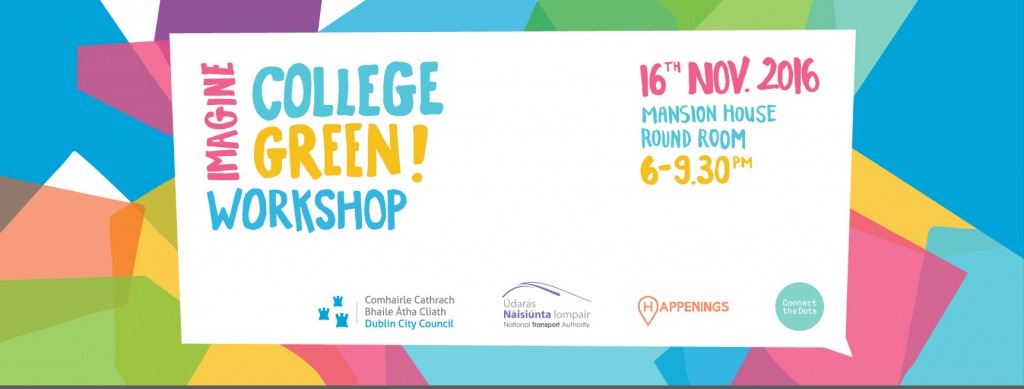Imagine College Green as Dublin’s most important Public Space. A Public Consultation Workshop regarding the design of a Civic Space at College Green.
16 November 2016
MANSION HOUSE Round Room
18.00 – 21.30hrs
Refreshments on arrival
Dublin City Council in association with the National Transport Authority and assisted by ‘Happenings’ will be hosting a public discussion workshop regarding the design of a Civic Plaza at College Green.
The aim is to convene a public forum where citizens, interested parties, focus groups and designers can identify and discuss the challenges and opportunities at College Green. The discussions will inform the brief for the designers to be appointed for College Green.
To attend the workshop please register at: https://www.eventbrite.ie/e/open-call-imagine-college-green-with-dublin-city-council-tickets-28866359057
Background
The importance of College Green as a public space and place of assembly can be traced through the history of Dublin as far back as the original Viking settlement. It has continued to serve in this capacity to varying degrees throughout history. College Green as we know it was laid out by the Wide Street Commissioners in 1782, when it was decided to provide a wide and unobstructed route between Dublin Castle and the Parliament House (Bank of Ireland), which would be terminated by the grand façade of Trinity College. Before the work of the Wide Street Commissioners College Green provided the only large open paved space in the heart of the city where assemblies could take place.
The streetscape has been the subject of extensive change, particularly during the second half of the 20th century. Early photographs and views of College Green depict a clean, uncluttered, open space with expansive views towards Trinity College and the Bank of Ireland. From the start of the 20th century onwards, the space gradually became more cluttered, with the provision of bicycle parking, traffic control signage and signals. During the second half of the 20th century the median islands were formed, at first providing parking for cars before being paved and planted for trees. Now they also contain the memorials to Henry Grattan and Thomas Davis.
College Green is enclosed by buildings of national and international importance, most notably the Bank of Ireland and Trinity College, and contains a number of sculptural monuments of artistic significance. The Bank of Ireland, formerly the Parliament House, is notably one of the earliest purpose-built parliament houses in the western world and represents a major episode in Palladian architecture. It was designed by Edward Lovett Pearce and was constructed from 1728 to 1739. Between 1782 and 1784 James Gandon prepared 3 successive schemes for an extension and a new portico’d entrance to the House of Lords which were completed by 1789. Following the Act of Union in 1801, Francis Johnston designed the conversion of the Parliament Houses into the Bank buildings in 1803.
In recent years the quality of the public space at College Green has suffered from increasing traffic levels, overcrowded footpaths resulting in pedestrians navigating across fast moving traffic lanes. All of these issues impact negatively on the experience of people using the space.
Opportunity
An opportunity has been presented by the current LUAS Cross City works to fulfil the policy and objectives set out in the Dublin City Development Plan to upgrade College Green and to promote the creation of a new public realm space of prime civic importance at College Green. It is proposed to close the carriageway on Dame Street creating a large civic space in front of the Bank of Ireland, which will incorporate Foster Place South and the memorials to Henry Grattan and Thomas Davis.
The Design of a Civic Space
In considering the challenge that the design of a Civic Space at College Green poses, the issues to be raised and discussed at the Public Discussion Workshop on 16th November 2016 will include:
– Historic context
– Existing monuments & art
– Pedestrian / cycling experience
– Public events
– Enlivenment – active, interesting place to be, temporary uses
– Night-time – experience, feel, quality, lighting, security
– Universal design – designed for all
– Greening & planting
– Seating – permanent & temporary
– Signage & information
Workshop
The Public Consultation event on November 16th 2016 is your chance to influence the future of Dublin City Centre. The ideas and suggestions from this meeting will be presented to the chosen design team for the new College Green.
Register on Eventbrite – https://www.eventbrite.ie/e/open-call-imagine-college-green-with-dublin-city-council-tickets-28866359057

